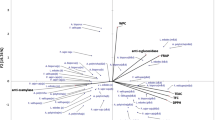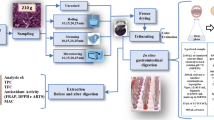Abstract
This study aimed to investigate the effect of four cooking methods with different durations on the in vitro antioxidant activities of five edible mushrooms, namely Agaricus bisporus, Flammulina velutipes, Lentinula edodes, Pleurotus ostreatus and Pleurotus eryngii. Among the raw samples, A. bisporus showed the highest total antioxidant activity (reducing power and radical scavenging), total flavonoid, ascorbic acid and water soluble phenolic contents. Short-duration steam cooking (3 min) increased the total flavonoid and ascorbic acid while prolonged pressure cooking (15 min) reduced the water soluble phenolic content in the mushrooms. The retention of antioxidant value in the mushrooms varied with the variety of mushroom after the cooking process. The cooking duration significantly affected the ascorbic acid in the mushrooms regardless of cooking method. To achieve the best antioxidant values, steam cooking was preferred for F. velutipes (1.5 min), P. ostreatus (4.5 min) and L. edodes (4.5 min) while microwave cooking for 1.5 min was a better choice for A. bisporus. Pressure cooked P. eryngii showed the best overall antioxidant value among the cooked samples. Optimised cooking method including pressure cooking could increase the antioxidant values in the edible mushrooms.
Similar content being viewed by others
References
Aherne SA, O’Brien NM (2002) Dietary flavonols: chemistry, food content, and metabolism. Nutrition 18(1):75–81
Aida FMNA, Shuhaimi M, Yazid M, Maaruf AG (2009) Mushroom as a potential source of prebiotics: a review. Trends Food Sci Technol 20(11–12):567–575
AOAC International (1995) Vegetable products, processed. In: Cunnif P (ed) Official methods of analysis of AOAC International, vol 2, 16th edn. AOAC International, Gaithersburg, p 4 (Chapter 42)
Benzie IFF, Strain JJ (1996) The ferric reducing ability of plasma (FRAP) as a measure of “antioxidant power”: the FRAP assay. Anal Biochem 239(1):70–76
Brennan C, Brennan M, Derbyshire E, Tiwari BK (2011) Effects of extrusion on the polyphenols, vitamins and antioxidant activity of foods. Trends Food Sci Technol 22(10):570–575
Chang CC, Yang MH, Wen HM, Chern JC (2002) Estimation of total flavonoid content in propolis by two complementary colorimetric methods. J Food Drug Anal 10(3):178–182
Cheng GY, Liu J, Tao MX, Lu CM, Wu GR (2012) Activity, thermostability and isozymes of superoxide dismutase in 17 edible mushrooms. J Food Compost Anal 26(1–2):136–143
Cheng XF, Zhang M, Adhikari B (2013) The inactivation kinetics of polyphenol oxidase in mushroom (Agaricus bisporus) during thermal and thermosonic treatments. Ultrason Sonochem 20(2):674–679
Choi Y, Lee SM, Chun J, Lee HB, Lee J (2006) Influence of heat treatment on the antioxidant activities and polyphenolic compounds of Shiitake (Lentinus edodes) mushroom. Food Chem 99(2):381–387
Ferrari G, Soares A, Bazanella G, Bracht A, Souza C, Boer C, Peralta R (2012) Antioxidant properties of the most common edible mushrooms consumed in Brazil. In: Andres S, Baumann N (eds) Mushrooms: types, properties and nutrition, 1st edn. Nova Science Publishers Inc, New York, pp 285–297
Gerhauser C, Klimo K, Heiss E, Neumann I, Gamal-Eldeen A, Knauft J, Liu GY, Sitthimonchai S, Frank N (2003) Mechanism-based in vitro screening of potential cancer chemopreventive agents. Mutat Res Fund Mol Mech 523:163–172
Hang NL (1998) Colored illustrations of macrofungi mushrooms of China. China Agriculture Press, Beijing
Hossain MB, Barry-Ryan C, Martin-Diana AB, Brunton NP (2010) Effect of drying method on the antioxidant capacity of six Lamiaceae herbs. Food Chem 123(1):85–91
Islam T, Yu XM, Xu BJ (2016) Phenolic profiles, antioxidant capacities and metal chelating ability of edible mushrooms commonly consumed in China. LWT Food Sci Technol 72:423–431
Jagadish LK, Shenbhagaraman R, Kaviyarasan V (2009) Comparitive study on the antioxidant, anticancer and antimicrobial property of Agaricus bisporus (JE Lange) Imbach before and after boiling. Afr J Biotechnol 8(4):654
Jimenez-Monreal AM, Garcia-Diz L, Martinez-Tome M, Mariscal M, Murcia MA (2009) Influence of cooking methods on antioxidant activity of vegetables. J Food Sci 74(3):H97–H103
Kettawan A, Chanlekha K, Kongkachuichai R, Charoensiri R (2011) Effects of cooking on antioxidant activities and polyphenol content of edible mushrooms commonly consumed in Thailand. Pak J Nutr 10(11):1094–1103
Manzi P, Gambelli L, Marconi S, Vivanti V, Pizzoferrato L (1999) Nutrients in edible mushrooms: an inter-species comparative study. Food Chem 65(4):477–482
Miglio C, Chiavaro E, Visconti A, Fogliano V, Pellegrini N (2008) Effects of different cooking methods on nutritional and physicochemical characteristics of selected vegetables. J Agric Food Chem 56(1):139–147
Munyaka AW, Makule EE, Oey I, Van Loey A, Hendrickx M (2010) Thermal stability of L-ascorbic acid and ascorbic acid oxidase in Broccoli (Brassica oleracea var. italica). J Food Sci 75(4):C336–C340
Ng ZX, Chai JW, Kuppusamy UR (2011) Customized cooking method improves total antioxidant activity in selected vegetables. Int J Food Sci Nutr 62(2):158–163
Ng ZX, Chua KH, Kuppusamy UR (2014) Proteomic analysis of heat treated bitter gourd (Momordica charantia L. var. Hong Kong Green) using 2D-DIGE. Food Chem 148:155–161
Nicoli MC, Anese M, Parpinel M (1999) Influence of processing on the antioxidant properties of fruit and vegetables. Trends Food Sci Technol 10(3):94–100
Oki T, Masuda M, Furuta S, Nishiba Y, Terahara N, Suda I (2002) Involvement of anthocyanins and other phenolic compounds in radical-scavenging activity of purple-fleshed sweet potato cultivars. J Food Sci 67(5):1752–1756
Ozyurek M, Bener M, Guclu K, Apak R (2014) Antioxidant/antiradical properties of microwave-assisted extracts of three wild edible mushrooms. Food Chem 157:323–331
Podsedek A (2007) Natural antioxidants and antioxidant capacity of Brassica vegetables: a review. LWT Food Sci Technol 40(1):1–11
Radzki W, Ziaja-Soltys M, Nowak J, Rzymowska J, Topolska J, Slawinska A, Michalak-Majewska M, Zalewska-Korona M, Kuczumow A (2016) Effect of processing on the content and biological activity of polysaccharides from Pleurotus ostreatus mushroom. LWT Food Sci Technol 66:27–33
Re R, Pellegrini N, Proteggente A, Pannala A, Yang M, Rice-Evans C (1999) Antioxidant activity applying an improved ABTS radical cation decolorization assay. Free Radic Biol Med 26(9–10):1231–1237
Sánchez C (2017) Reactive oxygen species and antioxidant properties from mushrooms. Synth Syst Biotechnol 2(1):13–22
Somsub W, Kongkachuichai R, Sungpuag P, Charoensiri R (2008) Effects of three conventional cooking methods on vitamin C, tannin, myo-inositol phosphates contents in selected Thai vegetables. J Food Compost Anal 21(2):187–197
Subramaniam S, Rosdi MHB, Kuppusamy UR (2017) Customized cooking methods enhance antioxidant, antiglycemic, and insulin-like properties of Momordica charantia and Moringa oleifera. J Food Qual 2017:1–9
Sun LP, Bai X, Zhuang YL (2014) Effect of different cooking methods on total phenolic contents and antioxidant activities of four Boletus mushrooms. J Food Sci Technol 51(11):3362–3368
Szeto YT, Tomlinson B, Benzie IFF (2002) Total antioxidant and ascorbic acid content of fresh fruits and vegetables: implications for dietary planning and food preservation. Br J Nutr 87(1):55–59
Tan YS, Baskaran A, Nallathamby N, Chua KH, Kuppusamy UR, Sabaratnam V (2015) Influence of customized cooking methods on the phenolic contents and antioxidant activities of selected species of oyster mushrooms (Pleurotus spp.). J Food Sci Technol 52(5):3058–3064
Turkmen N, Sari F, Velioglu YS (2005) The effect of cooking methods on total phenolics and antioxidant activity of selected green vegetables. Food Chem 93(4):713–718
Wachtel-Galor S, Wong KW, Benzie IFF (2008) The effect of cooking on Brassica vegetables. Food Chem 110(3):706–710
Zhang DL, Hamauzu Y (2004) Phenolics, ascorbic acid, carotenoids and antioxidant activity of broccoli and their changes during conventional and microwave cooking. Food Chem 88(4):503–509
Acknowledgements
The authors would like to thank MAHSA University for providing financial and technical assistance for this study.
Author information
Authors and Affiliations
Corresponding author
Electronic supplementary material
Below is the link to the electronic supplementary material.
Rights and permissions
About this article
Cite this article
Ng, Z.X., Tan, W.C. Impact of optimised cooking on the antioxidant activity in edible mushrooms. J Food Sci Technol 54, 4100–4111 (2017). https://doi.org/10.1007/s13197-017-2885-0
Revised:
Accepted:
Published:
Issue Date:
DOI: https://doi.org/10.1007/s13197-017-2885-0




